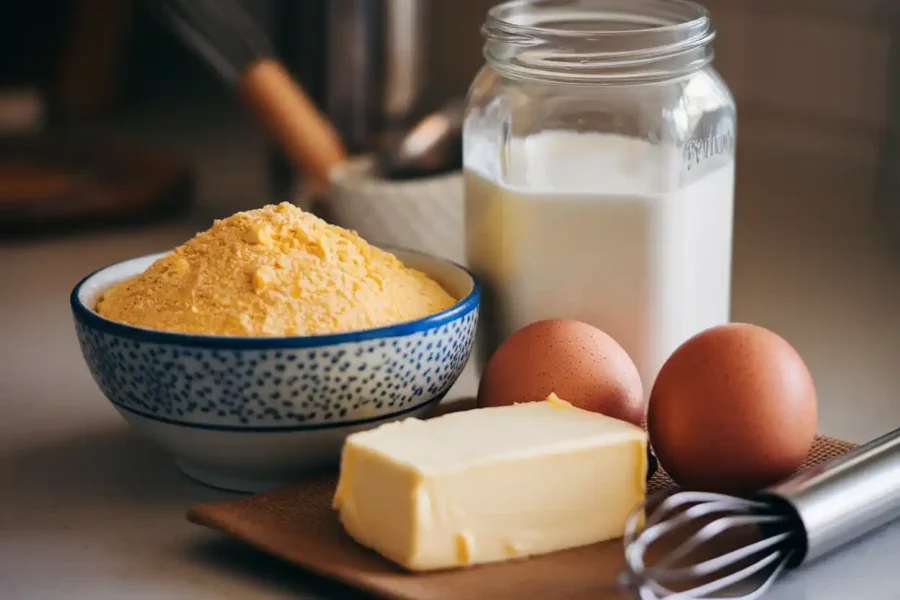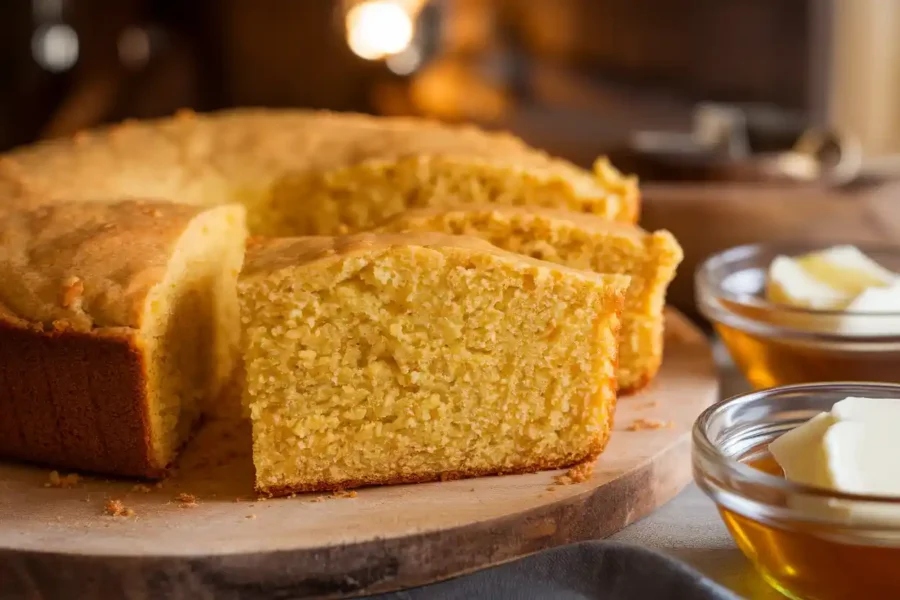Southern cornbread is more than just a dish; it’s a tradition rooted deep in the heart of Southern cooking. This article delves into the essence of Southern cornbread, from its rich history and signature ingredients to the step-by-step recipe that makes it so beloved. You’ll also discover expert tips, exciting variations, and answers to some of the most common questions about this timeless recipe. Whether you’re a seasoned cook or a kitchen newbie, this guide has all you need to whip up the perfect batch of Southern cornbread.
Table of Contents
Introduction to Southern Cornbread
What is Southern Cornbread?
Southern cornbread is a savory bread made primarily from cornmeal, often baked in a cast-iron skillet to achieve a golden crust. Unlike its sweeter, cake-like cousin found in other regions, Southern cornbread stands out for its rustic simplicity and authentic flavor. It’s traditionally made without sugar, emphasizing the natural taste of cornmeal, and is a staple in Southern meals. Whether paired with hearty stews or enjoyed on its own, this bread is pure comfort food.
A Brief History of Southern Cornbread
The origins of Southern cornbread trace back to Native American cuisine, where ground corn was a dietary mainstay. Early settlers adapted these techniques, creating recipes that evolved into the cornbread we know today. Over time, Southern cornbread became a symbol of resourcefulness, offering nourishment even during lean times. Its simplicity and versatility made it a cherished part of Southern culinary heritage.
Why Southern Cornbread Stands Out
What sets Southern cornbread apart is its texture and flavor. While other types of cornbread lean towards sweetness, this version prioritizes a savory taste, often enhanced by the tang of buttermilk. The use of a cast-iron skillet adds a delightful crunch to the crust, while the crumb remains tender and moist. It’s this combination of humble ingredients and expert technique that makes Southern cornbread a true culinary treasure.
Essential Ingredients for Southern Cornbread
The Core Ingredients for Authentic Southern Cornbread
At the heart of a great southern cornbread recipe are a few simple but crucial ingredients. First and foremost, cornmeal is the star preferably stone-ground, which retains a hearty texture and natural flavor. Buttermilk provides a subtle tang and moisture, enhancing the bread’s richness. A bit of baking soda or baking powder ensures a fluffy crumb, while eggs bind everything together. For a perfect crust, a generous dollop of melted butter or bacon grease greases the skillet, creating that iconic crispy edge.
Cornmeal vs. Flour: What Makes Southern Cornbread Unique
Unlike other versions, Southern cornbread leans heavily on cornmeal, with little to no flour. This emphasis gives it a dense, crumbly texture that complements savory dishes. Using fine-ground cornmeal results in a smoother crumb, while coarser varieties add a rustic feel. Flour, when included, is used sparingly to soften the texture without overshadowing the corn flavor.
Why Southerners Skip Sugar in Cornbread
Traditionally, sugar is a no-go in Southern cornbread. The reasoning? Southern cornbread is meant to be savory, relying on cornmeal’s natural sweetness and the richness of butter or buttermilk. This stark contrast to sweeter Northern recipes preserves its place as a side dish, not a dessert. In fact, many Southerners consider adding sugar almost sacrilegious!
| Ingredient | Purpose in Cornbread | Possible Substitutes |
|---|---|---|
| Cornmeal | The heart and soul of cornbread, provides texture and flavor | Stone-ground cornmeal for a more rustic feel |
| All-Purpose Flour | Helps bind the batter and softens the texture | Omit for extra crumbly cornbread |
| Baking Powder | Leavens the bread, making it rise slightly | Baking soda + vinegar (if needed) |
| Salt | Enhances all the other flavors | No substitute essential! |
| Buttermilk | Adds moisture, richness, and a slight tang | Whole milk + lemon juice (if out of buttermilk) |
| Eggs | Helps with structure and fluffiness | Flax egg (for a vegan option) |
| Bacon Grease/Butter | Creates that crispy crust and adds richness | Vegetable oil or lard |

Traditional Southern Cornbread Recipe
Step-by-Step Recipe for Classic Southern Cornbread
- Preheat and Prepare: Heat your oven to 425°F (220°C) and place a cast-iron skillet inside to preheat. This ensures a golden, crispy crust.
- Mix Dry Ingredients: Combine 1 1/2 cups of cornmeal, 1/2 teaspoon of baking soda, and a pinch of salt in a bowl.
- Add Wet Ingredients: In a separate bowl, whisk together 1 cup of buttermilk, 2 beaten eggs, and 2 tablespoons of melted butter or bacon grease.
- Combine: Gradually fold the wet ingredients into the dry mixture until just combined. Avoid overmixing to keep the bread tender.
- Bake: Pour the batter into the preheated skillet, spreading it evenly. Bake for 20-25 minutes or until golden brown.
- Cool and Serve: Allow the cornbread to cool slightly before slicing. Serve warm for the best flavor.
Common Mistakes to Avoid When Making Cornbread
- Skipping the Preheated Skillet: This step is crucial for achieving a crispy crust.
- Overmixing the Batter: Too much stirring leads to dense, chewy cornbread.
- Using Cold Ingredients: Room-temperature buttermilk and eggs mix better and yield a smoother batter.
Tips for Perfect Texture and Taste Every Time
For a more buttery flavor, drizzle melted butter over the top before serving. Want a bit of crunch? Fold in some fresh or roasted corn kernels. And for a richer taste, try adding a dollop of sour cream to the batter.
Variations of Southern Cornbread
Buttermilk Cornbread: A Rich Southern Tradition
Buttermilk cornbread takes the southern cornbread recipe up a notch with its tangy flavor and moist texture. This variation swaps regular milk for buttermilk, which reacts with baking soda to create a light and tender crumb. Buttermilk also enhances the natural corn flavor, making this an irresistible addition to any Southern meal. For an extra twist, try using full-fat buttermilk for even more richness.
Adding a Twist: Jalapeño, Cheese, and More
One of the joys of cornbread is how versatile it is. Want a spicy kick? Add diced jalapeños. Craving something cheesy? Stir in shredded cheddar or Monterey Jack. For a savory surprise, mix in crumbled bacon or chopped scallions. These additions bring a modern flair to the southern cornbread recipe while keeping the traditional base intact.
How to Make Gluten-Free Southern Cornbread
For those avoiding gluten, this recipe can easily adapt. Use gluten-free cornmeal and a gluten-free all-purpose flour blend. Ensure all your ingredients, including baking soda and buttermilk, are certified gluten-free to avoid cross-contamination. Despite the swaps, this version retains the classic flavor and crumbly texture of the original.
Southern Cornbread in Culture and Cuisine
Cornbread as a Staple in Southern Meals
Cornbread isn’t just a dish; it’s a symbol of Southern hospitality. From family dinners to holiday feasts, this humble bread finds its way to the table alongside staples like fried chicken, collard greens, and black-eyed peas. It’s especially popular during celebrations, where its savory simplicity complements richer dishes.
Cornbread Pairings: What Goes Best with This Classic
The southern cornbread recipe shines when paired with hearty meals. It’s the perfect side for chili, gumbo, or a steaming bowl of bean soup. Crumble it over greens or dip it into gravy for a true taste of the South. Its slightly crumbly texture also makes it a fantastic base for cornbread stuffing, a holiday favorite.
Cornbread in Southern Celebrations and Traditions
Southern cornbread has been a part of family traditions for generations. At potlucks and barbecues, cornbread often takes center stage. In some regions, it’s even a must-have for New Year’s Day meals, symbolizing wealth and prosperity when served with black-eyed peas and greens.
Expert Tips for Mastering Southern Cornbread

Achieving the Perfect Crust: Cast Iron Secrets
A preheated cast-iron skillet is the key to a flawless crust. Before pouring in the batter, heat the skillet with a tablespoon of butter or bacon grease in the oven. This creates a sizzling base that ensures your cornbread emerges with an irresistibly golden and crunchy crust.
How to Ensure Moist and Fluffy Cornbread
Achieving the ideal texture in a southern cornbread recipe involves a few simple tricks. First, use room-temperature ingredients, as they mix more evenly. Second, avoid overmixing the batter stir just until combined to prevent a dense loaf. Lastly, don’t skimp on the buttermilk or eggs, as these ingredients are essential for a moist and tender crumb.
Common Mistakes and How to Avoid Them
Overmixing: A Common Pitfall
One of the easiest ways to ruin a southern cornbread recipe is by overmixing the batter. Stirring too much activates the gluten in the flour, leading to a tough, chewy texture. Instead, gently fold the wet ingredients into the dry mixture just until combined. A few lumps are perfectly fine they’ll disappear during baking.
Using the Wrong Type of Cornmeal
The choice of cornmeal can make or break your cornbread. Opt for stone-ground cornmeal for its authentic texture and rich flavor. Fine-ground cornmeal works well for a smoother crumb, but avoid cornmeal mixes that already contain leavening agents or sugar. These can alter the balance of your southern cornbread recipe and produce unexpected results.
Frequently Asked Questions (FAQs)
What is the Difference Between Cornbread and Southern Cornbread?
Cornbread and Southern cornbread may share a name, but their flavors and textures are quite different. While traditional cornbread often includes sugar for a sweeter profile, the southern cornbread recipe is all about savory simplicity. Southern cornbread uses more cornmeal than flour and skips the sugar, giving it a dense, crumbly texture perfect for pairing with savory dishes. Additionally, Southern cornbread is almost always baked in a preheated cast-iron skillet, resulting in a crispy, golden crust.
Why Do Southerners Not Put Sugar in Cornbread?
Southerners take pride in preserving the authentic, savory flavor of cornbread. Historically, adding sugar was unnecessary because the cornmeal itself provided natural sweetness. The southern cornbread recipe reflects this tradition, ensuring the bread complements savory dishes like greens or chili without overpowering them.
Is it Better to Use Buttermilk or Milk in Cornbread?
Buttermilk is a game-changer for cornbread. Its tangy flavor and slightly thick texture not only enhance the bread’s taste but also create a softer crumb. The acid in buttermilk reacts with baking soda, making the cornbread rise beautifully. While regular milk can be used in a pinch, buttermilk is the preferred choice in an authentic southern cornbread recipe.
How Do You Store and Reheat Southern Cornbread?
To keep cornbread fresh, store it in an airtight container at room temperature for up to two days. For longer storage, wrap it tightly and freeze it for up to three months. When reheating, place it in an oven at 350°F (175°C) for 10-15 minutes to restore its crispy edges and warm center.
Conclusion: Why Southern Cornbread is a Must-Try
A Simple Yet Timeless Recipe
The southern cornbread recipe is proof that simplicity is often the key to the most satisfying dishes. With just a few humble ingredients and the right techniques, you can create a dish that’s rich in flavor and steeped in tradition. It’s a versatile side that pairs beautifully with countless meals or can be enjoyed on its own.
Bring Southern Comfort to Your Table
Whether you’re hosting a family gathering or craving a taste of Southern comfort, this recipe is a must-try. Its crispy crust, tender crumb, and savory flavor capture the essence of Southern cooking. Once you’ve mastered this classic dish, you’ll find it becomes a cherished part of your own recipe collection.

